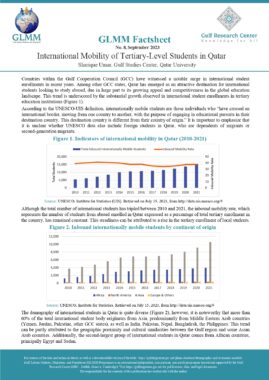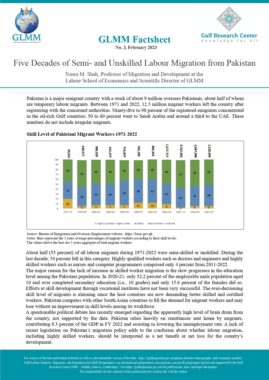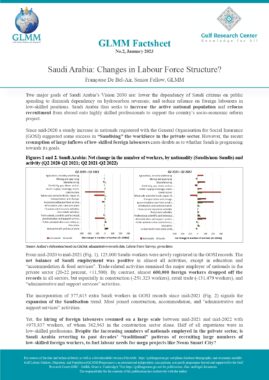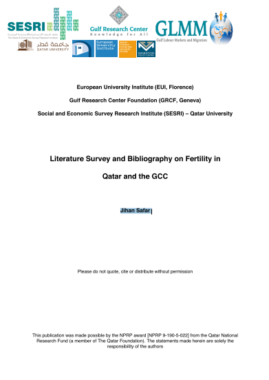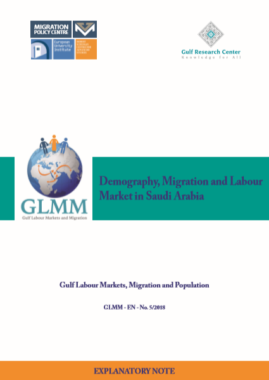GCC: Percentage of nationals and non-nationals in employed population in GCC countries (2020)
| Employed | % in employed population | ||
| Country | population | Nationals | Non-nationals |
| Bahrain (Q4 2020) | 687,700 | 22.2 | 77.8 |
| Kuwait (Q4 2020) | 2,661,784 | 15.3 | 84.7 |
| Oman (end of 2020) | 1,859,657 | 23.2 | 76.8 |
| Qatar (end of 2020) | 2,128,766 | 5.2 | 94.8 |
| Saudi Arabia (Q4 2020) | 13,318,698 | 24.4 | 75.6 |
| UAE | NA | NA | NA |
Sources: national institutes of statistics
1- Definitions and remarks:
Non-nationals are:
1- persons bearing nationality of a foreign State other than the GCC State of residence, or bearing
no proof of nationality from any given state
(stateless persons and holders of refugee status and travel document in a third country);
2- Holders of residence permit residing in the given GCC country at date of census, as per definition
of residence used in each of the countries.
Employment refers to: all persons of working age (15 and above), who during a reference period
worked to produce goods or provide services for pay (cash or kind) or worked for profit from their
own (or partially owned)business or worked without pay in the family business or with other
individuals. It also includes those who have a temporary absence from a job during the reference
period due to vacation or illness or any other reason.
Figures refer to workers employed in all sectors of activity (governmental, private and
domestic services).
Oman: Employment data does not include those employed in the Defense, Armed Forces,
and Police (Military) of the governmental sector.
Omani Employees in government companies and Omanis working in GCC (insure in Civil Service
Pension Fund) has been included in 2019.
Bahrain: Data retrieved from LMRA-BLMI (administrative data) differ from other sources of data
See for instance: GCC Stat. Labour Statistics for Q2 2020,
https://gccstat.org/images/gccstat/docman/publications/labour_statistics2020_1.pdf
UAE: No numbers available.
2- Sources of data:
Bahrain: Labour Market Regulation Authority (LMRA). Bahrain Labour Market Indicators (BLMI),
Q4 2020, http://blmi.lmra.bh/2020/12/mi_dashboard.xml
Kuwait: Central Statistical Bureau. Integrated Database – LMIS, Q4 2019.
https://lmis.csb.gov.kw/
Oman: National Center for Statistics and Information. Data portal, “Manpower” data, 2020.
https://data.gov.om/byvmwhe/labour-market#.
Qatar: Planning and Statistics Authority. Annual Bulletin of Labour Force Sample Survey 2020
https://www.psa.gov.qa/en/statistics/Statistical%20Releases/Social/LaborForce/2020/Annual_Bulletin_Labour_force_2020_AE.xlsx
Saudi Arabia: General Authority for Statistics (GAStat). Labour Force Survey 2020, Q4.
https://www.stats.gov.sa/en/814
Last accessed: June 2022.
Similar Posts:
- GCC: Percentage of nationals and non-nationals in employed population in GCC countries (2019)
- GCC: Number of employed workers and percentage of non-nationals in employed population in GCC countries (2015-2021) (private sector)
- GCC: EMP 1.1 Percentage of nationals and non-nationals in employed population in GCC countries (2016)
- GCC: Percentage of nationals and non-nationals in employed population in GCC countries (2015)
- GCC: Employed population and percentage of non-nationals in employed population in GCC countries (2015-2023) (private sector)
Tags: Bahrain, Foreign Labour, Gulf Cooperation Council, Kuwait, National & Foreign Labour, National Labour, Oman, Qatar, Saudi Arabia, United Arab Emirates

































